
Opossums are members of the marsupial order Didelphimorphia endemic to the Americas. The largest order of marsupials in the Western Hemisphere, it comprises 126 species in 18 genera. Opossums originated in South America and entered North America in the Great American Interchange following the connection of North and South America.
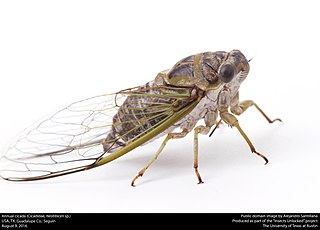
Cicadidae, the true cicadas, is the largest family of cicadas, with more than 3,200 species worldwide. The oldest known definitive fossils are from the Paleocene, a nymph from the Cretaceous Burmese amber has been attributed to the family, but could also belong to the Tettigarctidae.

Ranatra is a genus of slender predatory insects of the family Nepidae, known as water scorpions or water stick-insects. There are around 100 Ranatra species found in freshwater habitats around the world, both in warm and temperate regions, with the highest diversity in South America and Asia. Fewer are found elsewhere, but include several African, some in North America, three from Australia and three from the Palearctic, notably the relatively well-known European R. linearis. Since Ranatra belongs to the family Nepidae which in turn belongs to the order Hemiptera, ranatrids are considered "true bugs".

Nysius is a genus of false chinch bugs in the family Lygaeidae. At least 100 described species are placed in Nysius.

Delphacidae is a family of planthoppers containing about 2000 species, distributed worldwide. Delphacids are separated from other "hoppers" by the prominent spur on the tibia of the hindleg.

The Cicadinae are a subfamily of cicadas, containing the translucent cicadas. They are robust cicadas and many have gaudy colors, but they generally lack the butterfly-like opaque wing markings found in many species of the related Tibiceninae.

Heterogastridae is a family of lygaeoid bugs consisting of about 20 genera and more than 100 species.

Issidae is a family of planthoppers described by Spinola in 1839, belonging to the order Hemiptera, suborder Auchenorrhyncha superfamily Fulgoroidea.
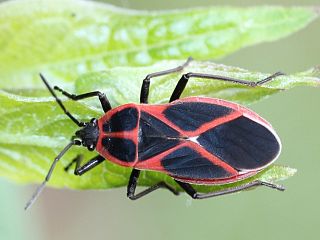
Tropidothorax is a genus of seed bugs or ground bugs belonging to the family Lygaeidae, subfamily Lygaeinae.There are about 11 described species in Tropidothorax.

Phiala is a genus of moths in the family Eupterotidae.

The Blissidae are a family in the Hemiptera, comprising nearly 50 genera and 400 species. The group has often been treated as a subfamily of the Lygaeidae but was resurrected as a full family by Thomas Henry (1997).
Chamus is a genus of Miridae or capsid bugs in the tribe Dicyphini and subtribe Odoniellina. Species can be found in central and southern Africa, with the type C. wealei first described by Distant in 1904.
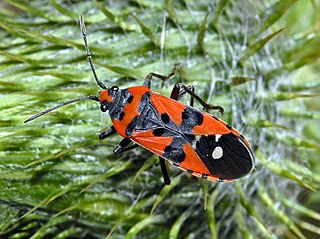
Lygaeus is a genus of seed bugs in the family Lygaeidae. There are more than 60 described species in Lygaeus.

Kinnaridae is a family of fulgoroid planthoppers. This is a small family with a little more than 20 genera and about a 100 species. The family was erected by Muir in 1925 and most members are found in the Oriental and Neotropical regions and only a few in the Nearctic and Palaearctic regions.
Cercotmetus is a genus of water bugs in the subfamily Ranatrinae. The recorded distribution of this genus is from is from mainland Asia to New Guinea and northern Australia.

Euander is a genus of dirt-colored seed bugs in the family Rhyparochromidae. There are at least four described species in Euander, found in Australia.

Lycorma imperialis is a planthopper indigenous to parts of China and Indo-Malaysia. L. imperialis was originally discovered in 1846 by Adam White and has one recognized non-nominate subspecies, L. i. punicea. L. imperialis has undergone a number of reclassifications since its discovery and is one of four species in the genus Lycorma. L. imperialis follows a hemimetabolous life cycle and will undergo a series of nymphal stages (instars) before maturing to an adult.
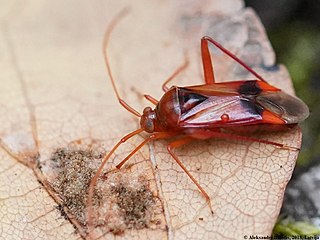
Megacoelum is a genus of European, African, Asian and Australian capsid bugs in the tribe Mirini, erected by Franz Xaver Fieber in 1858. The species Megacoelum infusum is recorded from northern Europe including the British Isles.
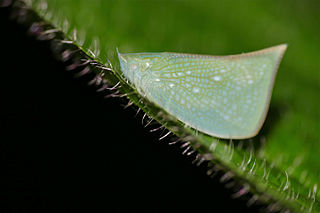
Lawana is a genus of planthoppers in the family Flatidae, erected by William Lucas Distant in 1906. In 1923, Leopold Melichar confirmed placement of this genus in tribe Flatini and subtribe Lawanina. Species are recorded from tropical Africa and Asia.

















